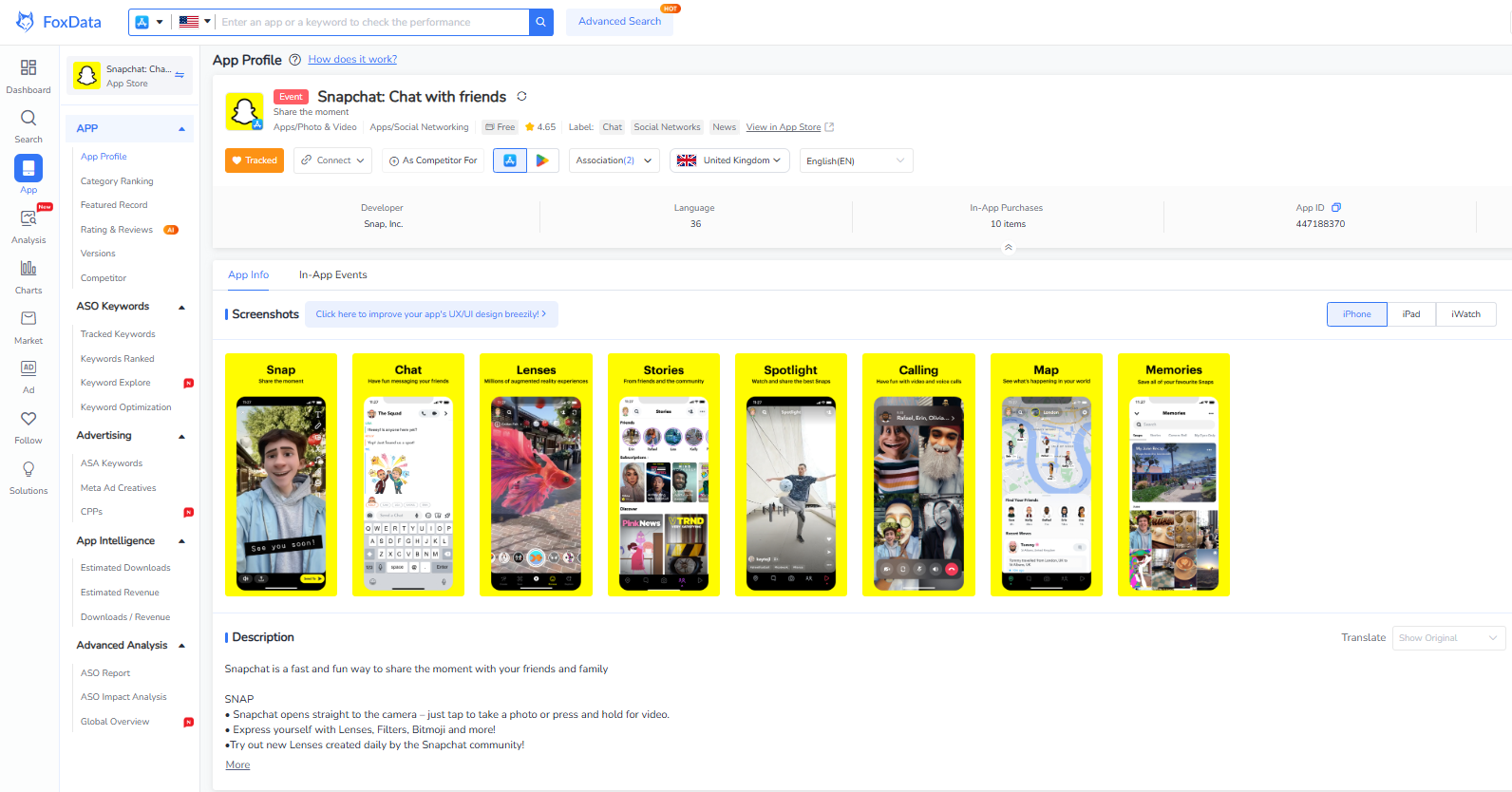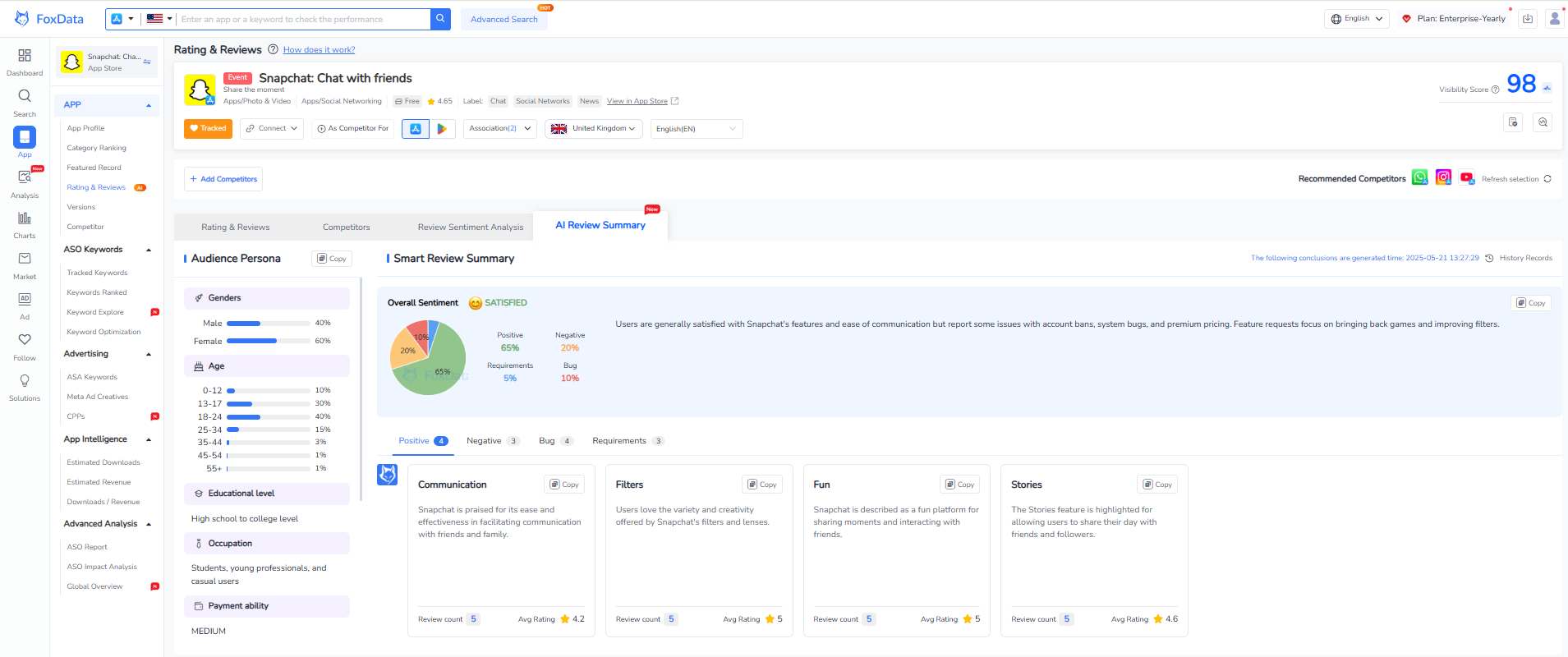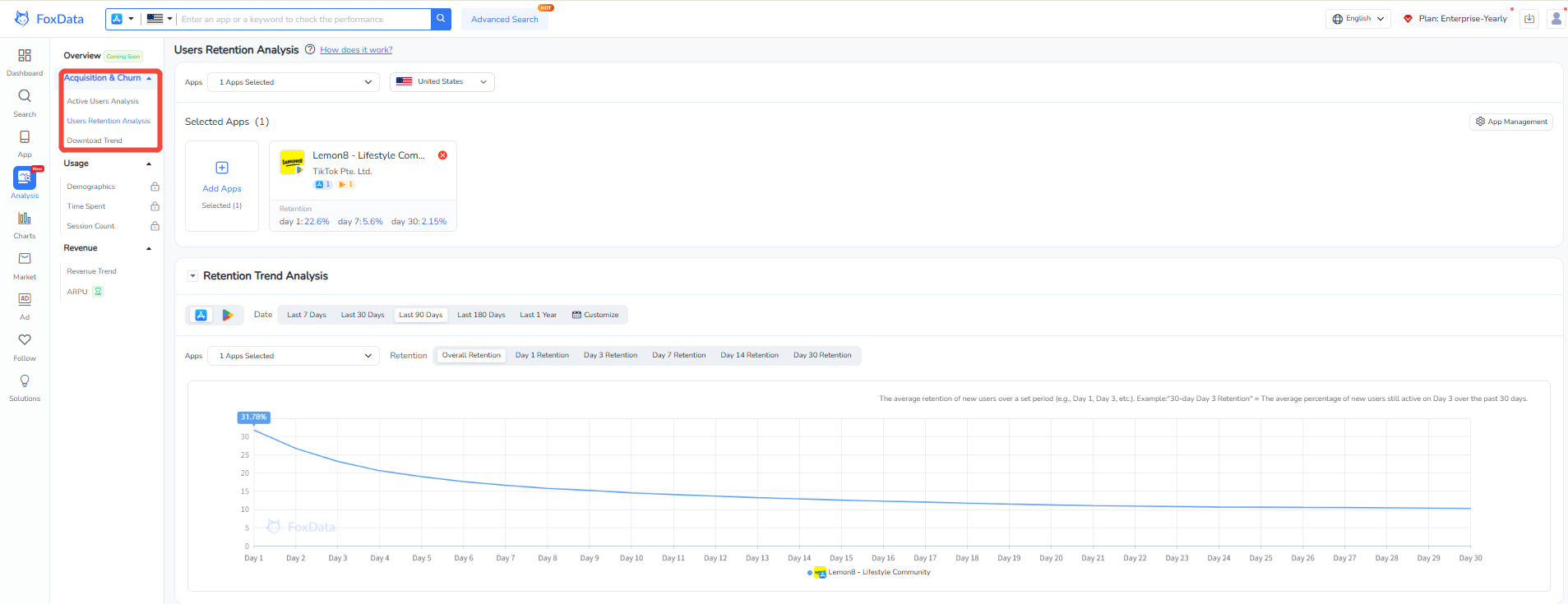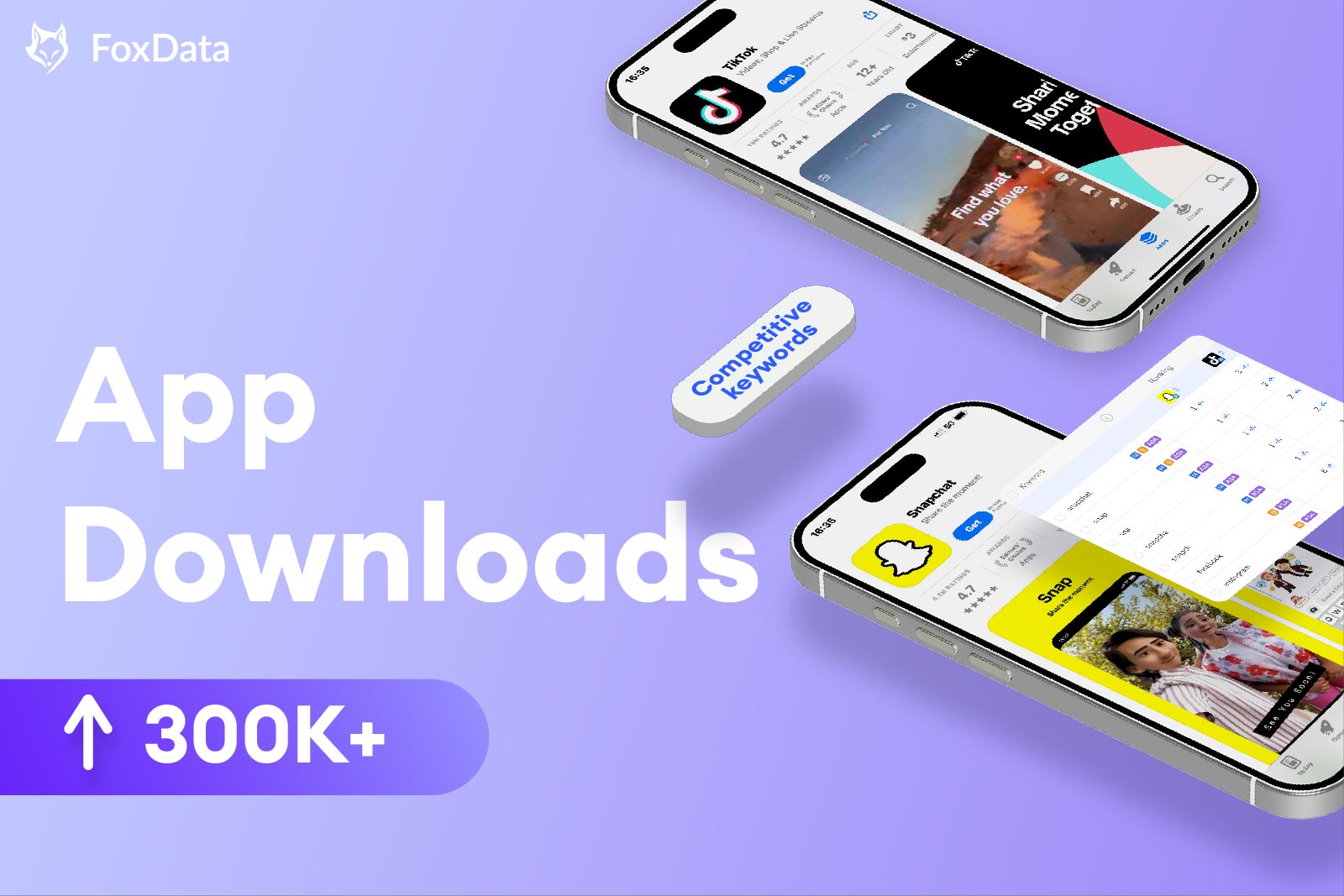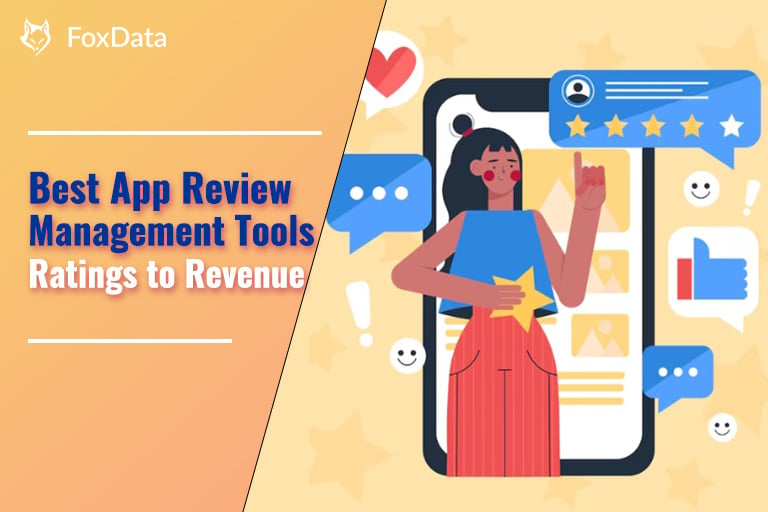Google Play Store Optimization: The Ultimate Guide (For Android Apps)
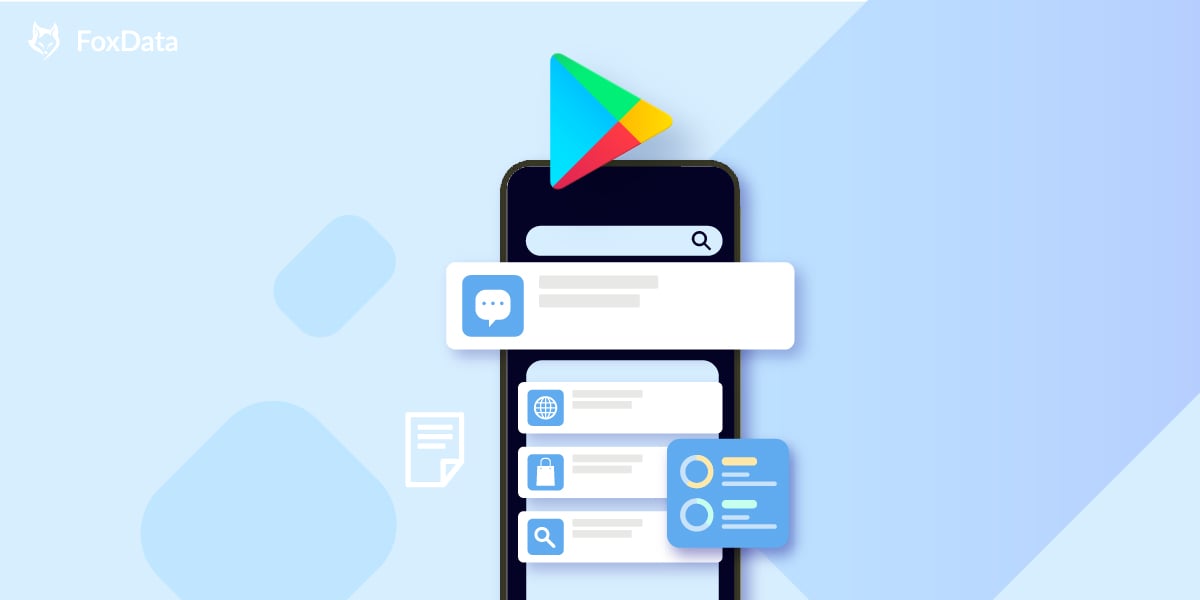
Key Takeaways
1. Google Play ASO drives visibility, installs, and retention by optimizing keywords, metadata, and user experience to align with Google’s ranking and recommendation signals.
2. Well-structured metadata—Title, Short Description, and Full Description—should balance keyword relevance with clear messaging to improve both ranking and conversions.
3. Strong creatives (icons, screenshots, videos) are critical to boosting tap-through and conversion rates; continuous testing is essential.
4. Ratings, reviews, and retention metrics (like session frequency and uninstall rate) directly impact store ranking and user trust—optimize them proactively.
5. Effective ASO is ongoing: use platforms like FoxData to track performance, benchmark competitors, and adapt to trends like localization and promotional content.
What is Google Play Store Optimization?
Since its launch in September 2008, the Google Play Store has evolved significantly. Google has continuously optimized the platform—especially in ways that improve app discoverability for users. Borrowing principles from SEO (Search Engine Optimization), which was originally intended for websites, Google gradually adapted these ideas for app ecosystems. This gave rise to ASO (App Store Optimization), a parallel yet distinct discipline from traditional SEO.
When users search for certain features or keywords in Google Play, how does the algorithm decide which apps to show first? The answer lies in Google’s ranking algorithm, which evaluates multiple elements of your Play Store listing to determine how well your app matches user intent. The better the keyword relevance, the higher the chances your app will rank—leading to greater visibility and more organic installs.
Keyword relevance is one of the cornerstones of Google Play ASO. To help developers improve app performance, Google has released features such as Promotional Content, Store Listing Experiments (A/B Testing), and Pre-registration, giving teams more control and flexibility over their app marketing initiatives.
Ultimately, the main goals of Google Play ASO are to:
- Increase organic app installs.
- Boost visibility through discovery channels such as Search, Explore, Ads, and Google’s Recommendation System.
- Improve conversion rates with high-quality creative assets (icons, screenshots, videos, etc.).
- Strengthen overall paid user acquisition strategies with complementary organic efforts.
How does the Google Play ranking and recommendation algorithm work?
Although Google Play Store optimization may seem challenging at first, you can systematically adjust your optimization strategy to effectively improve your app's organic exposure and download performance in the store once you have clarified the key elements that the Google ranking algorithm focuses on.
The following are the main factors that affect your organic ranking and visibility in Google Play:
1. Text Metadata: App title, short description, and detailed description
Google matches apps with users' search requests based on the content of the app's metadata, and the keywords contained directly affect the ranking in the search results. For example, if a user searches for "cooking recipes" and your app title or description happens to contain this keyword phrase, the probability of being recognized and recommended by the algorithm will be greatly increased.
As shown by the app "Cookpad Recipes, Homemade Cuisine", it has comprehensively laid out the word "cooking recipes" in its metadata, so it ranks at the top of the list for this keyword in Google Play in the United States.
💬 FoxData Tips:
- Ensure your app description accurately reflects your app's functionality and content.
- Highlight your app's key features. Showcase what makes your app engaging and unique.
- Keep your app description concise. Users often only read the first few sentences.
2. User behavior data: Real interaction signals
It is not only keyword matching that can affect the ranking, but also the interaction behavior of users with the app is equally important. Google tracks these behavioral patterns and judges the relevance and user experience quality of the app accordingly.
For example, when a user clicks and installs your app after searching for a keyword, and if he continues to be active in the next 30 days, this will be regarded as a strong positive signal, which will help improve the ranking under that keyword. Conversely, if the user uninstalls shortly after installation, the algorithm will determine that the app has not met the user's expectations, which will affect the ranking performance.
3. User ratings and reviews: Dual drivers of conversion and ranking
Just as we tend to check the product ratings when we shop online, Google also regards ratings and reviews as an important indicator of app quality. In the store details page, the rating and review information will be directly presented, affecting the user's decision to click and download.
In addition, if the app rating is below 3 stars (i.e., below 60 points on a 5-point scale), it may lose the opportunity to be displayed in the "Explore" section of Google Play. Therefore, maintaining positive reviews and responding to user feedback in a timely manner is critical to improving conversion rates and exposure.
4. Android Vitals: Technical performance affects ranking
Google uses the Android Vitals monitoring system to identify the stability and technical performance of apps. High crash rates, serious lag, or other performance issues will trigger algorithm penalties, resulting in reduced exposure.
Fortunately, developers can view the app's operational data and health through Android Vitals in the Google Play Console to identify problems early and optimize performance to improve overall ranking competitiveness.
5. Update frequency and content freshness
The algorithm also particularly favors apps with high activity and frequent updates. Google encourages developers to maintain connections with users and improve platform recommendation willingness by regularly releasing updates and "Promotional Content".
Frequent updates not only mean bug fixes and feature optimizations, but also indicate to Google that the app is "fresh and relevant", which in turn leads to higher store recommendation priority.
🔍 In FoxData, you can analyze other apps' promotional content on Google Play, providing inspiration for your own Play Store optimization.
How to Optimize App Metadata
App metadata is the first and strongest signal to Google about how your app relates to a user's search query. You must optimize it precisely:
App Title
- Character limit: 30 characters—embed main keyword(s) smartly.
- Include brand terms to reinforce identity (e.g., “XX VPN – Fast & Secure Internet Access”).
- Avoid keyword stuffing and banned terms like “free,” “best,” or “#1.”
- Avoid using all caps unless it's part of the brand name. Refrain from using irrelevant emojis, emoticons, and special characters.
✅ Use keyword coverage analysis to preview traffic potential and competition for keywords in your title, and compare against industry standards.
Short Description
- Limit: 80 characters. Displayed right after the app name.
- Combine the core keyword with one compelling value proposition or feature.
- Ideal for A/B testing emotional phrasing vs. functional copy.
Full Description
- Limit: 4,000 characters. Google extracts important keyword signals from this section.
- Structure: Introduction (value prop) → Middle (functionality) → End (CTA + brand mention).
- Recommendation: Repeat each keyword 3–5 times for balance—no stuffing.
App Category & Tags
- App categories and tags help users discover the most relevant content.
- If your app fits in multiple categories, choose one with a lower competition level to improve the chance of trending.
- You can assign up to 5 tags. Google suggests some, but you're free to explore and pick those that describe your app best.
- Tag accuracy directly affects app visibility in the Play Store.
Keyword Research and Optimization Strategies
Keyword optimization is the foundation of organic visibility.
Finding High-Opportunity Keywords
- Use FoxData’s keyword tools to analyze search volume, difficulty, and trend graphs.
- Source ideas from autocomplete suggestions and competitor listings.
- Group using brand terms, feature terms, use-case terms, and pain-point-related terms.
Grouping and Placement
- Place core keywords in the title and short description.
- Long-tail keywords go in the full description for supplemental traffic.
- Localize keywords for multilingual listings based on region.
✅ Use the “Keyword Explore” feature to identify actual ranking keywords and optimize layout structure—and analyze which terms help competitors outrank you.
⬆️ With FoxData, you can analyze competitors’ keyword strategies to improve your own.
Creative Asset Optimization (Icons, Screenshots, Videos)
Visual elements influence conversion rates and enhance tap-through rate (CTR).
App Icon
- Keep it clean, bold, highly recognizable.
- Avoid using small text or overly detailed visuals—they lose clarity on smaller phone screens.
- Icon A/B testing can significantly boost CTR—use Google Play’s native feature or FoxData’s heatmap module.
- To ensure product details display correctly across various screen sizes, design with scalability in mind, and center key elements within the image.
Screenshots + Preview Video
- First 3 screenshots are critical—highlight top selling points up front.
- Add brief captions to each image with user-focused benefits.
- Videos should convey the app's core value in under 30 seconds (include usage context + testimonials).
- To ensure product details display correctly across various screen sizes, design with scalability in mind, and ensure key elements are centrally positioned within the image.
✅ FoxData offers competitive intelligence on App profile displays across various app stores, assisting in visual optimization for your own product.
User Ratings & Review Management
Ratings and reviews influence both Google’s ranking algorithm and user trust:
- A rating above 4.2 significantly improves conversion.
- A score below 3.0 lowers your exposure in recommendations and rankings.
- First visible reviews hold the most weight in user decision-making.
How to Encourage Positive Ratings & Manage Reviews?
- Prompt reviews at high-satisfaction touchpoints (e.g., after a purchase or feature unlock).
- Quickly respond to negative reviews—apps with developer replies have a 20%+ chance of improved ratings.
- Use sentiment and clustering tools to spot trends (e.g., “lags,” “crashes,” “scam” terms).
📌 Use FoxData’s AI Review Summary to extract themes and analyze sentiment faster.
Localization Strategy
Localization is one of the most sustainable growth channels for ASO when expanding into new markets. However, simple translation is not enough; keyword research and content localization are the truly effective methods.
Here's a simple process to guide your localization strategy:
- Identify Target Regions:
First, assess which markets have already shown potential. Review your app's existing downloads, revenue, and even search volume in different countries/regions to evaluate its awareness and momentum.
- Research Cultural and Visual Trends:
Explore how competitors in your category present themselves locally. AppTweak's ASO Creatives Explorer can help you scan local store listings, discover creative trends, and identify visual or cultural cues that can be applied to your own screenshots.
- Adjust and Verify Creatives:
Enter the design phase and create wireframes that reflect your research findings. Once completed, have a native speaker review your visuals and captions to ensure that nothing is missed during translation and that all content aligns with local culture.
- Track Performance by Region:
To measure the success of localization, track key metrics for each market, such as the best-performing keywords, conversion rates, average ratings, retention rates, and uninstall rates. This helps you determine which regions are responding best and which ones need further optimization.
Key Localization Points:
- English: login/log in
- China Mainland: 登录
- Taiwan: 登入
- Japan: ログイン
- Korea: 로그인
Localized keywords must appear in Title, Short Description & Full Description.
Avoid culturally sensitive icons or colors. Ensure inclusivity in visuals.
Continuous Monitoring & A/B Testing for Iteration
ASO is not a set-it-and-forget-it task—it thrives on continuous testing and validation.
Key Metrics for A/B Testing:
- Impressions
- Tap-through rate (TTR)
- View-to-Install Conversion Rate
- Retention & Churn rate
✅ Use FoxData’s KPI tracking dashboard to monitor performance across dimensions, compare against past performance, and quickly identify divergences.
FoxData Users Retention Analysis
How to Run A/B Tests
- Google Play Console enables A/B testing of icons, screenshots, and assets with real users.
- FoxData monitors the impact of version updates on traffic sources, ratings, and keyword performance.
- Example test areas: Icon styles, two short description tones, and screenshot display order.
Common Google Play ASO Mistakes to Avoid
To succeed with Google Play Store optimization, it's crucial to employ the right strategies and avoid common pitfalls. Here are some key areas where developers often overlook or misuse tactics during implementation:
1. Keyword Stuffing
Similar to SEO, excessive keyword stuffing won't boost rankings and could backfire. While strategically repeating target keywords can enhance relevance, it can also hurt user experience and conversions if it disrupts text flow and readability.
It's worth noting that Google's algorithms are sophisticated enough to recognize keywords and assess the overall coherence and clarity of your text. Therefore, when writing content, balance keyword optimization with content quality, adhering to the principle of "natural integration and smooth phrasing."
2. Over-reliance on A/B Testing with Low Traffic
For apps that are newly launched or have a small user base, constantly waiting for A/B test results can be inefficient. We often hear developers say, "The test ran for months, and the feedback was still very limited." In such cases, we recommend a more practical optimization process: skip A/B testing, directly release updates, and evaluate their impact two weeks after launch. If the data doesn't meet expectations, revert to the original version. This approach saves significant time when traffic is low while still effectively driving store page optimization.
3. Ignoring Promotional Content
For games and event-driven apps, a lack of a consistent promotional content strategy often means missing out on additional exposure from Google.
Google Play strongly encourages developers to use the "Promotional Content" mechanism to periodically showcase limited-time events or significant updates within the app/game. This not only helps improve user retention but also potentially earns additional featured placements. We recommend publishing promotional content every seven days and maintaining a display cycle of about seven days to continuously maintain visibility in the "Hot Events" section.
How do you measure the effectiveness of your Google Play Store optimization?
Want to know if your ASO strategy is working? Focus on the data.
Google Play not only focuses on downloads but also on recommending apps that retain users in the long term. Retention rate is a strong indicator of app quality, and the algorithm takes this into account when deciding which apps to highlight in the Play Store.
To ensure your ASO efforts are fruitful, monitor key retention metrics such as average session duration, usage frequency (daily, weekly, or monthly opens), and uninstall rate. These metrics help Google determine if your app has lasting value and is worth promoting.
💡 FoxData's Time Spent and Session Count features
- If you've optimized your metadata (e.g., app title or description), focus on changes in store visits from "Search" and "Explore."
- If you've changed creative assets like screenshots, icons, or preview videos, you need to pay attention to the "Conversion Rate" metric, as visual content usually has the most direct impact on conversion.
📌 With third-party ASO platforms like FoxData, you can more easily track keyword coverage, conversion data trends, changes in user feedback, and other core dimensions, helping you identify problems and make quick adjustments.
Google Play ASO in Summary
Today, Google Play Store Optimization has evolved beyond simply "adding a few keywords and updating an icon." It's transforming into a comprehensive, data-driven, user-experience-focused growth methodology that spans the entire user lifecycle.
A successful ASO strategy often involves multiple facets:
- Boosting keyword coverage to enhance search visibility.
- Designing high-converting icons, screenshots, and videos.
- Guiding and managing authentic user reviews.
- Implementing in-depth localization for emerging or high-potential markets.
- Integrating timely paid promotion and user acquisition strategies.
Crucially, ASO should not be viewed as a checklist of tasks to be performed periodically, but rather as a continuous optimization process. It requires ongoing experimentation, data analysis, and strategic iteration to maintain a competitive edge in the rapidly changing app market.
We believe that a truly successful app optimization strategy should encompass three core dimensions: technical performance stability, continuous enhancement of user value, and differentiated creative content dissemination.
❗ Interested in how FoxData can help scale your ASO efforts globally? Try our platform for free.
The Future of ASO on Google Play
Google Play ASO is evolving. Here’s where it’s heading:
1. Contextual Keywords and Semantic Themes Will Gain Importance
While keywords remain fundamental, Google is becoming increasingly adept at understanding semantic context. Instead of simply stuffing keywords, it's more effective to build a semantic structure centered around "keyword clusters" to better align with user search intent. This also demands stronger overall logic and lexical diversity in the content.
2. The Weight of Video Content Will Continue to Rise
Google currently allows developers to link their YouTube channels to store pages. This opens up new ways to showcase visual content, helping to convey core values through more immersive media, enhancing the user experience and conversion efficiency.
3. Promotional Content Becomes a New Engine for Exposure
Especially for game apps, Google is continuously strengthening the exposure mechanism for "time-sensitive content," including holiday events, limited-time challenges, and character unlocks. Regularly updating promotional content on app store pages not only helps increase user engagement but also aligns with Google's strategy of creating a contextual content consumption experience.
🔗 Click here for more ASO strategy output
FAQs: Common ASO Questions
Q1: Do all keywords need to be in the Title and Descriptions?
A: Not necessarily. Prioritize high-traffic, highly relevant ones in the Title first, then Short Description. Keep language natural and user-friendly—it's not about volume but clarity.
Q2: Do icons and screenshots impact installs significantly?
A: Absolutely. Your icon, screenshots, and preview greatly influence whether a user taps to download. A/B test them and stay ahead of creative benchmarks in your niche.
Q3: Should I start ASO even if my app just launched?
A: Yes! Early-stage ASO sets the foundation for visibility. Plan your keyword strategy, design creatives, and establish your rating pipeline from Day 1.
Q4: What’s the difference between “Explore Traffic” and “Search Traffic”?
A: Search Traffic stems from user queries. Explore Traffic results from recommendations, rankings, categories, or similar app placements. Strong ASO can boost both.
Q5: Should non-gaming apps use Promotional Content too?
A: Absolutely. Even for non-gaming use cases, use Promotional Content to highlight new features, time-sensitive deals, or important updates. It boosts engagement and surfaces your app in “featured” areas.
Q6: How do I measure app performance across markets?
A: Google Play Console offers baseline insights, but FoxData lets you analyze keyword performance, ranking, and competitor strength region by region for strategic localization.
Q7: Can I succeed without getting featured?
A: Yes. Editor Picks or Feature placements help, but aren’t the only traffic source. Solid metadata, reviews, and content strategy can secure plenty of organic downloads.
Final Word: Power Up Your App with the ASO Flywheel
ASO isn't a one-time checklist—it's a continuous, long-term growth engine tied to your product's lifecycle. Done right, it connects:
User Feedback → Data Insights → Creative Iteration
With tools like FoxData, you can reduce trial-and-error, track competitors, and iterate creatives efficiently. Whether you’re scaling in one market or globally, the combination of performance metrics, creative excellence, and keyword expansion is your path to success.
🎯 Sign up for a free FoxData account now and instantly access your app's keyword coverage performance across global markets!


